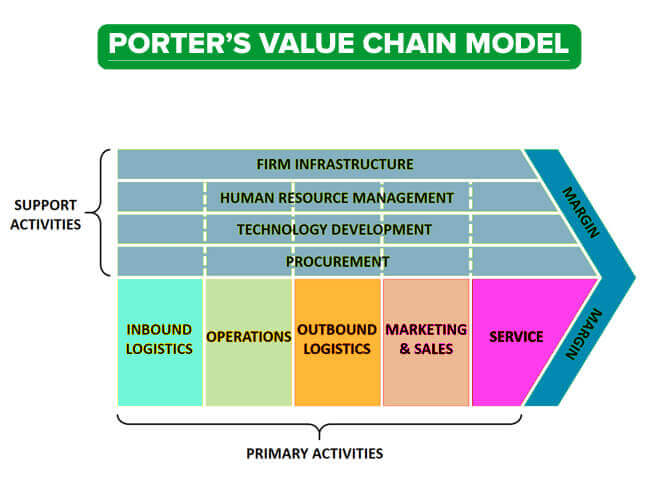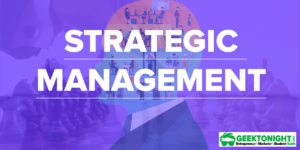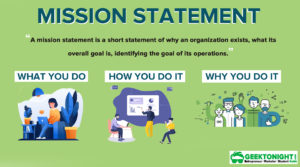Topic Covered: What is value chain analysis, definition, meaning, Steps, Importance, advantage and disadvantage of value chain analysis, classification of Porter’s Value Chain model.
Table of Content
Value Chain Definition
Every organisation consists of a chain of activities that link together to develop the value of the business. The value chain identifies where the value is added in the process and links it with the main functional parts of the organisation.
It is used for developing competitive advantage because such chains tend to be unique to an organisation. It then attempts to make an assessment of the contribution that each part makes to the overall added value of the business.
Essentially, Porter linked two areas together:
- the added value that each part of the organisation contributes to the whole organisation
- the contribution that each part makes to the competitive advantage of the whole organisation.
Value Chain thus views the organisation as a chain of value-creating activities. Value is the amount that buyers are willing to pay for what a product provides them.
What is Value Chain Analysis?
The value chain model is also known as Porter’s Value Chain model. The analysis is a business management tool that was developed by Michael Porter and described in his popular book Competitive Advantage: Creating and Sustaining Superior Performance in 1985.
Value chain analysis is a process where firm focuses on analyzing its primary and support activities of a business in an effort to understand costs, locate the activities that add the most value, and differentiate from the competition.
Classification of Porter’s Value Chain model
According to Porter’s Value Chain model, value chain activities are divided into two broad categories, as shown in the figure.
- Primary activities
- Support activities

Primary Activities
Primary activities contribute to the physical creation of the product or service, its sale and transfer to the buyer and its service after the sale. The primary activities are inbound logistics, operations/production, outbound logistics, marketing, and services.
Inbound Logistics
These activities focus on inputs. They include material handling, warehousing, inventory control, vehicle scheduling, and returns to suppliers of inputs and raw materials.
Operations
These include all activities associated with transforming inputs into the final product, such as production, machining, packaging, assembly, testing, equipment maintenance etc.
Outbound Logistics
These activities are associated with collecting, storing, physically distributing the finished products to the customers. They include finished goods warehousing, material handling and delivery, vehicle operation, order processing and scheduling.
Marketing and Sales
These activities are associated with the purchase of finished goods by the customers and the inducement used to get them to buy the products of the company. They include advertising, promotion, salesforce, channel selection, channel relations and pricing.
Services
This includes all activities associated with enhancing and maintaining the value of the product. Installation, repair, training, parts supply and product adjustment are some of the activities that come under services.
Support Activities
Support activities include such activities as procurement, HR etc. which either add value by themselves or add value through primary activities and other support activities.
Procurement
Activities associated with purchasing and providing raw materials, supplies and other consumable items as well as machinery, laboratory equipment, office equipment etc.
Porter refers to procurement as a secondary activity, although many purchasing gurus would argue that it is (at least partly) a primary activity. Included are such activities as purchasing raw materials, servicing, supplies, negotiating contracts with suppliers, securing building leases and so on.
Technology Development
Activities relating to product R&D, process R&D, process design improvements, equipmentdesign, computer software development etc.
Human Resource Management
Activities associated with recruiting, hiring, training, development, compensation, labour relations, development of knowledge-based skills etc.
Firm Infrastructure
Activities relating to general management, organisational structure, strategic planning, financial and quality control systems, management information systems etc.
Johnson and Sholes (2002) observe that few organisations undertake all activities from production of raw materials to the point–of–sale of finished products themselves. But, the value chain exercise must incorporate the whole process, that is, the entire value system.
For example, even if an organisation does not produce its own raw materials, it must nevertheless seek to identify the role and impact of its supply sources on the final product.
Similarly, even if it is not responsible for after-sales service, it must consider how the performance of those who deliver the service contribute to overall product/service cost and quality.
Read: What is Strategic Management Process?
Conducting a Value Chain Analysis
Steps in value chain analysis
Identify Activities
The first step in value chain analysis is to divide a company’s operations into specific activities and group them into primary and secondary activities.
Within each category, a firm typically performs a number of discrete activities that may reflect its key strengths and weaknesses.
Allocate Costs
The next step is to allocate costs to each activity. Each activity in the value chain incurs costs and ties up time and assets. Value chain analysis requires managers to assign costs and assets to each activity.
It views costs in a way different from traditional cost accounting methods. The different method is called activity-based costing.
Identify the Activities that Differentiate the Firm
Scrutinizing the firm’s value chain not only reveals cost advantages or disadvantages but also identifies the sources of differentiation advantages relative to competitors.
Examine the Value Chain
Once the value chain has been determined, managers need to identify the activities that are critical to buyer satisfaction and market success. This is essential at this stage of the value chain analysis for the following reasons:
- If the company focuses on low-cost leadership, then managers should keep a strict vigil on costs in each activity. If the company focuses on differentiation, an advantage given by each activity must be carefully evaluated.
- The nature of the value chain and the relative importance of each activity within it, vary from industry to industry.
- The relative importance of the value chain can also vary by a company’s position in a broader value system that includes value chains of upstream suppliers and downstream distributors and retailers.
- The interrelationships among value-creating activities also need to be evaluated. The final basic consideration in applying value chain analysis is the need to use a comparison. when evaluating a value activity as a strength or weakness. In this connection, RBV and SWOT analysis will supplement the value chain analysis.
The final basic consideration in applying value chain analysis is the need to use a comparison when evaluating a value activity as a strength or weakness. In this connection, RBV and SWOT analysis will supplement the value chain analysis.
Finally, in assessing the value chains there are two levels that must be addressed
- Interrelationships among the activities within the firm.
- Relationships among the activities within the firm and with other organisations that are a part of the firm’s expanded value chain.
Read: What is Strategic Management? Characteristics, Risk, Benefits
Importance of Value Chain Analysis
The value chain analysis is useful to recognize that individual activities in the overall production process play an important role in determining the cost, quality and image of the end-product or service.
Analyzing the separate activities in the value chain helps management to address the following issues:
- Which activities are the most critical in reducing cost or adding value? If quality is a key consumer value, then ensuring the quality of supplies would be a critical success factor.
- What are the key cost or value drivers in the value chain?
- What linkages help to reduce cost, enhance value or discourage imitation?
- How do these linkages relate to the cost and value drivers?
The value chain model is a useful management tool for identifying the firm’s core competencies and the activity that give them a competitive advantage as follow: Cost Advantage and Differentiation Advantage.
Cost Advantage
This approach is used when the firm tries to compete on costs and wants to understand the source of their cost advantage and disadvantage and what factors drive those cost.
Porter identified the following as the most important cost and value drivers:
Cost Drivers
- Economies of scale
- Pattern of capacity utilization
- Linkages between activities
- Interrelationships
- Geographical location
- Policy choices
- Institutional factors
Differentiation Advantage
The firms that strive to create superior products or service use differentiation advantage approach.
Value Drivers
Value drivers are similar to cost drivers, but they relate to other features (other than low price)valued by buyers. Identifying value drivers comes from understanding customer requirements, which may include:
- Policy choices
- Linkages between activities
The cost and value drivers vary between industries. The value chain concept shows that companies can gain competitive advantage by controlling cost or value drivers and/or reconfiguring the value chain, that is, a better way of designing, producing, distributing or marketing a product or service.
For example, Ryanair has become one of the most profitable airlines in Europe through concentrating on the parts of its value chain, such as ticket transaction costs, no-frills etc.
Advantages of Value Chain Analysis
- Fully understand the associated costs and areas of differentiation by breaking product and service activities into smaller pieces.
- Identify those activities where you can quickly reduce cost, optimize effort, eliminate waste, and increase profitability.
- Analyzing activities also gives insights into elements that bring greater value to the end-user.
Disadvantages of Value Chain Analysis
- Not a simple practice to implement a firm operates in a dynamic environment.
- Difficulties involved in gathering the data and find appropriate information in order to break your value chain down into primary and supporting activities.
- Difficulties in finding the appropriate information in order to break your value chain down into primary and supporting activities.
Go On, Tell Us What You Think!
Did we miss something? Come on! Tell us what you think about our article on What is Value Chain Analysis? Definition, Model, Example in the comments section.
Business Ethics
(Click on Topic to Read)
- What is Ethics?
- What is Business Ethics?
- Values, Norms, Beliefs and Standards in Business Ethics
- Indian Ethos in Management
- Ethical Issues in Marketing
- Ethical Issues in HRM
- Ethical Issues in IT
- Ethical Issues in Production and Operations Management
- Ethical Issues in Finance and Accounting
- What is Corporate Governance?
- What is Ownership Concentration?
- What is Ownership Composition?
- Types of Companies in India
- Internal Corporate Governance
- External Corporate Governance
- Corporate Governance in India
- What is Enterprise Risk Management (ERM)?
- What is Assessment of Risk?
- What is Risk Register?
- Risk Management Committee
Corporate social responsibility (CSR)
Lean Six Sigma
- Project Decomposition in Six Sigma
- Critical to Quality (CTQ) Six Sigma
- Process Mapping Six Sigma
- Flowchart and SIPOC
- Gage Repeatability and Reproducibility
- Statistical Diagram
- Lean Techniques for Optimisation Flow
- Failure Modes and Effects Analysis (FMEA)
- What is Process Audits?
- Six Sigma Implementation at Ford
- IBM Uses Six Sigma to Drive Behaviour Change
Research Methodology
Management
Operations Research
Operation Management
- What is Strategy?
- What is Operations Strategy?
- Operations Competitive Dimensions
- Operations Strategy Formulation Process
- What is Strategic Fit?
- Strategic Design Process
- Focused Operations Strategy
- Corporate Level Strategy
- Expansion Strategies
- Stability Strategies
- Retrenchment Strategies
- Competitive Advantage
- Strategic Choice and Strategic Alternatives
- What is Production Process?
- What is Process Technology?
- What is Process Improvement?
- Strategic Capacity Management
- Production and Logistics Strategy
- Taxonomy of Supply Chain Strategies
- Factors Considered in Supply Chain Planning
- Operational and Strategic Issues in Global Logistics
- Logistics Outsourcing Strategy
- What is Supply Chain Mapping?
- Supply Chain Process Restructuring
- Points of Differentiation
- Re-engineering Improvement in SCM
- What is Supply Chain Drivers?
- Supply Chain Operations Reference (SCOR) Model
- Customer Service and Cost Trade Off
- Internal and External Performance Measures
- Linking Supply Chain and Business Performance
- Netflix’s Niche Focused Strategy
- Disney and Pixar Merger
- Process Planning at Mcdonald’s
Service Operations Management
Procurement Management
- What is Procurement Management?
- Procurement Negotiation
- Types of Requisition
- RFX in Procurement
- What is Purchasing Cycle?
- Vendor Managed Inventory
- Internal Conflict During Purchasing Operation
- Spend Analysis in Procurement
- Sourcing in Procurement
- Supplier Evaluation and Selection in Procurement
- Blacklisting of Suppliers in Procurement
- Total Cost of Ownership in Procurement
- Incoterms in Procurement
- Documents Used in International Procurement
- Transportation and Logistics Strategy
- What is Capital Equipment?
- Procurement Process of Capital Equipment
- Acquisition of Technology in Procurement
- What is E-Procurement?
- E-marketplace and Online Catalogues
- Fixed Price and Cost Reimbursement Contracts
- Contract Cancellation in Procurement
- Ethics in Procurement
- Legal Aspects of Procurement
- Global Sourcing in Procurement
- Intermediaries and Countertrade in Procurement
Strategic Management
- What is Strategic Management?
- What is Value Chain Analysis?
- Mission Statement
- Business Level Strategy
- What is SWOT Analysis?
- What is Competitive Advantage?
- What is Vision?
- What is Ansoff Matrix?
- Prahalad and Gary Hammel
- Strategic Management In Global Environment
- Competitor Analysis Framework
- Competitive Rivalry Analysis
- Competitive Dynamics
- What is Competitive Rivalry?
- Five Competitive Forces That Shape Strategy
- What is PESTLE Analysis?
- Fragmentation and Consolidation Of Industries
- What is Technology Life Cycle?
- What is Diversification Strategy?
- What is Corporate Restructuring Strategy?
- Resources and Capabilities of Organization
- Role of Leaders In Functional-Level Strategic Management
- Functional Structure In Functional Level Strategy Formulation
- Information And Control System
- What is Strategy Gap Analysis?
- Issues In Strategy Implementation
- Matrix Organizational Structure
- What is Strategic Management Process?
Supply Chain





